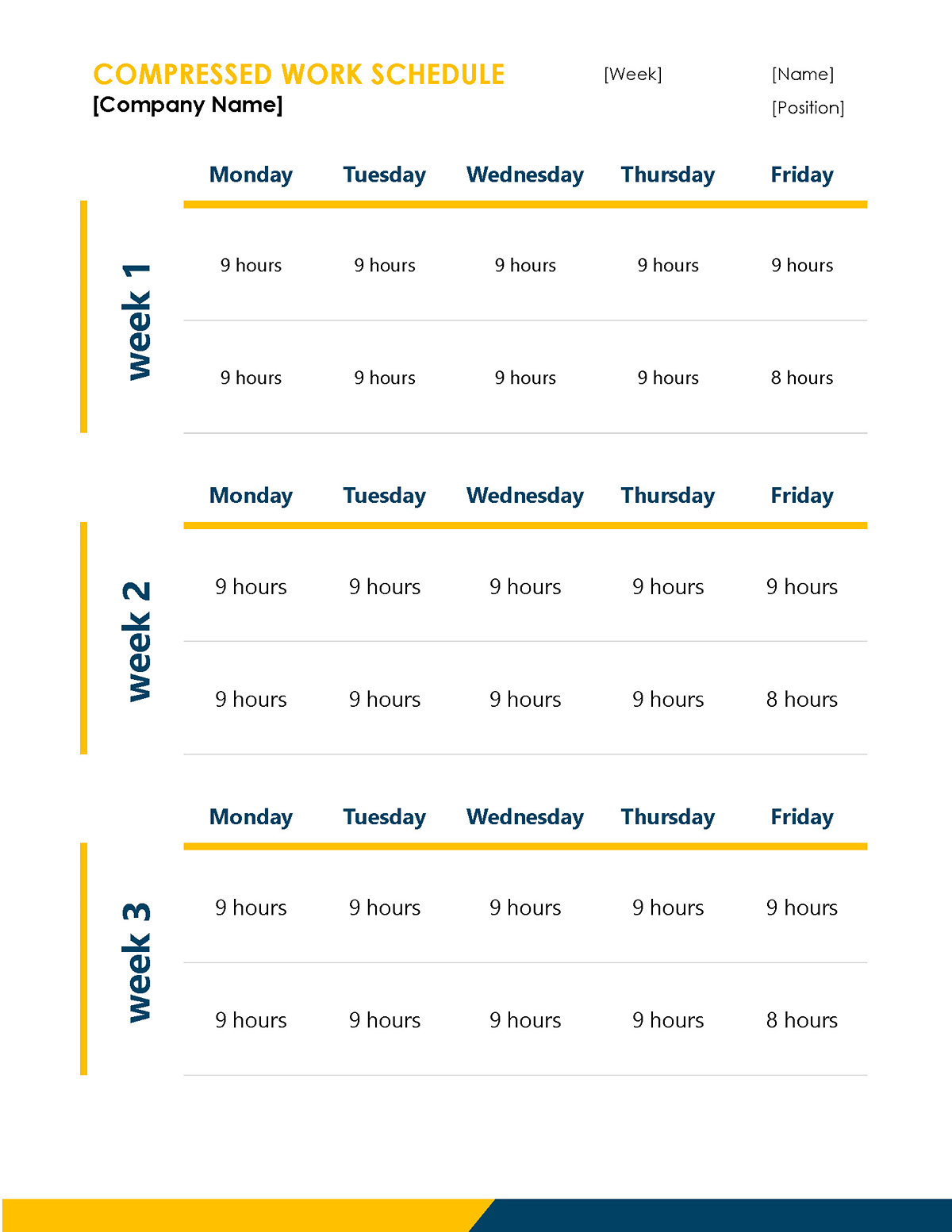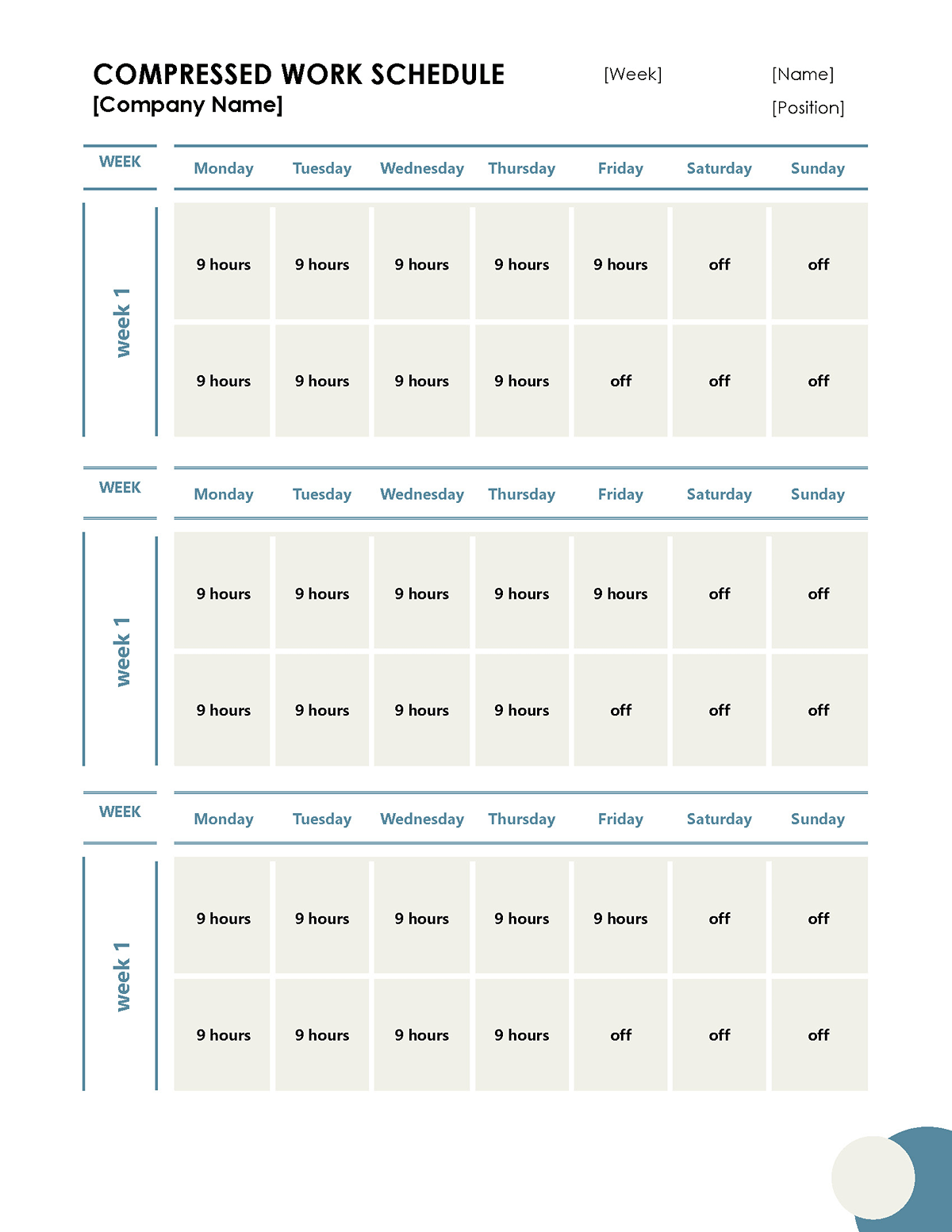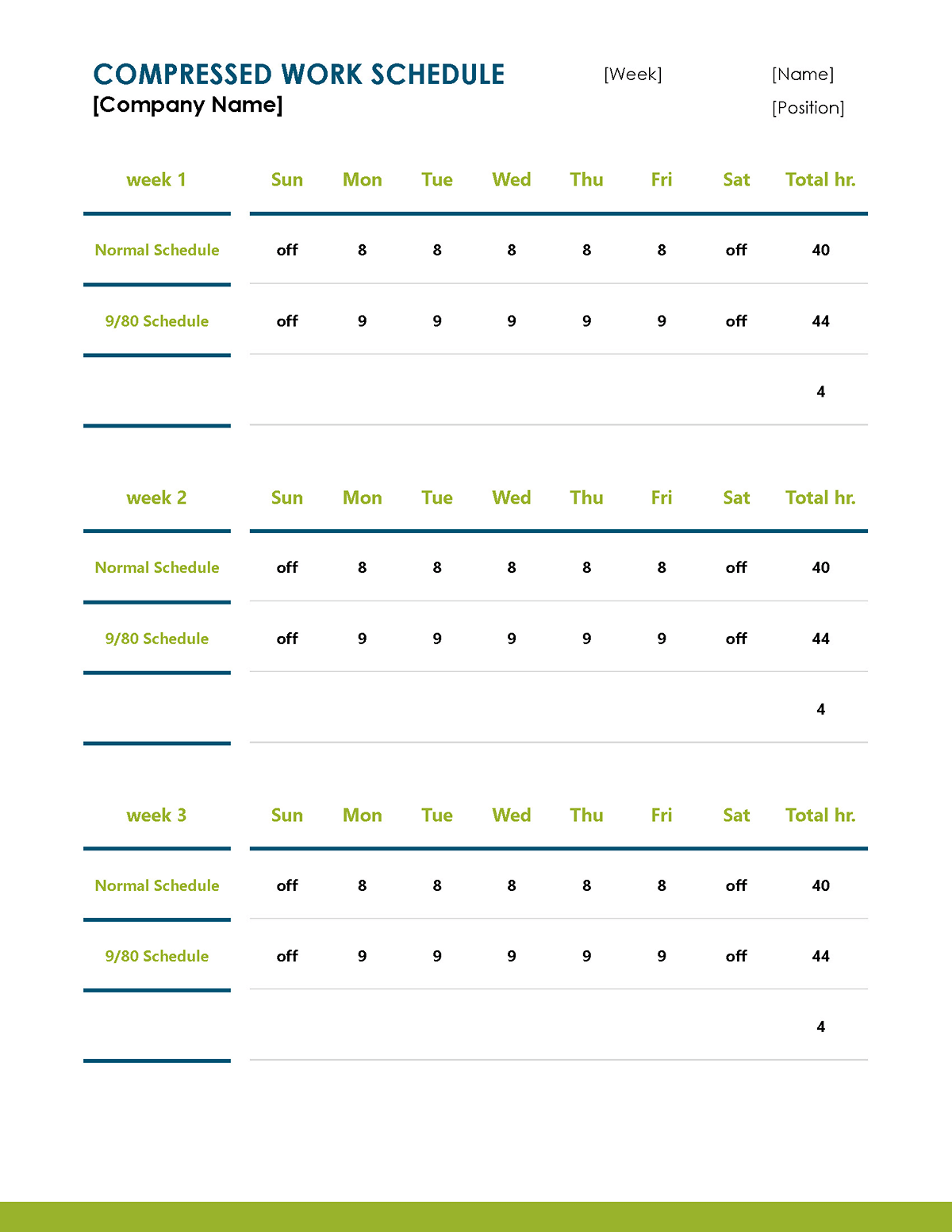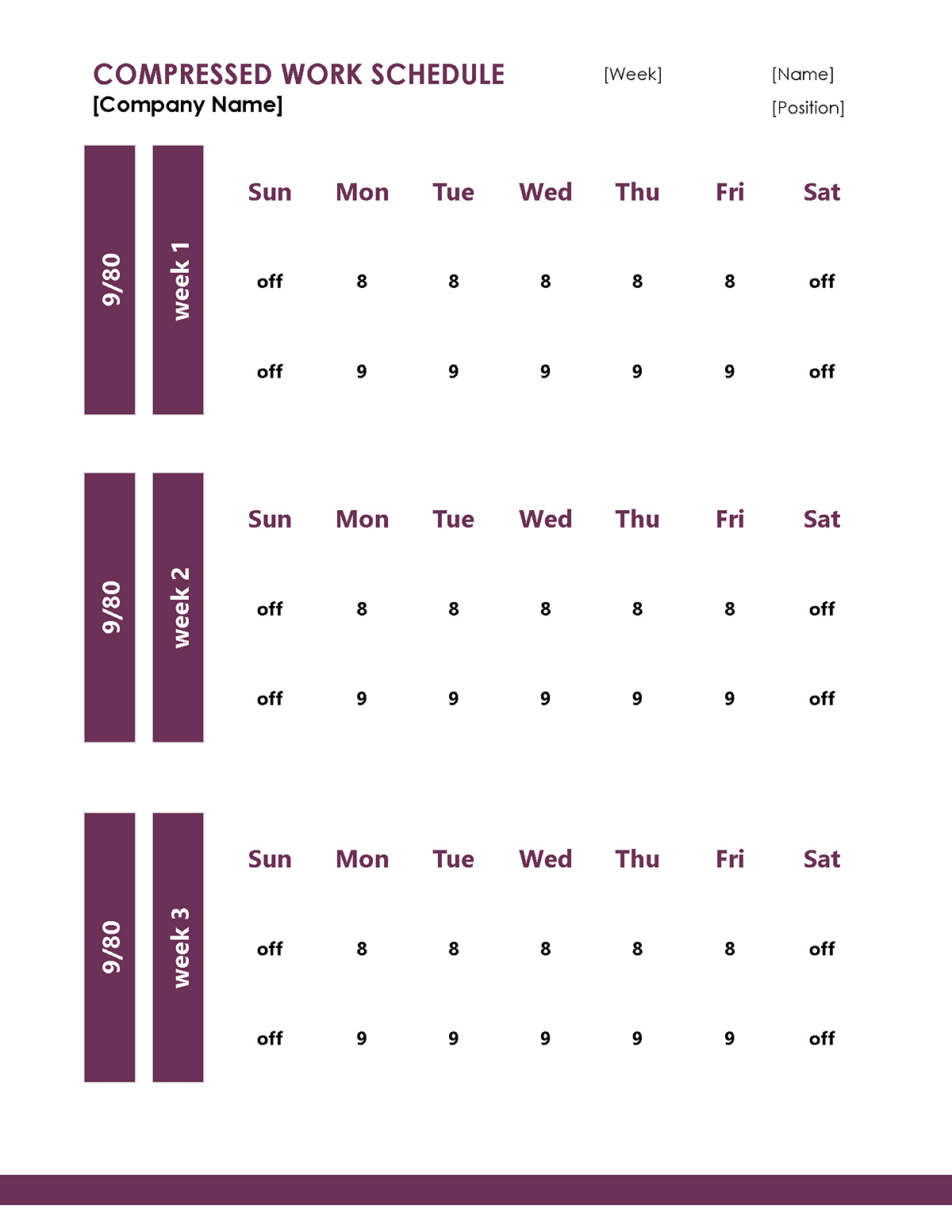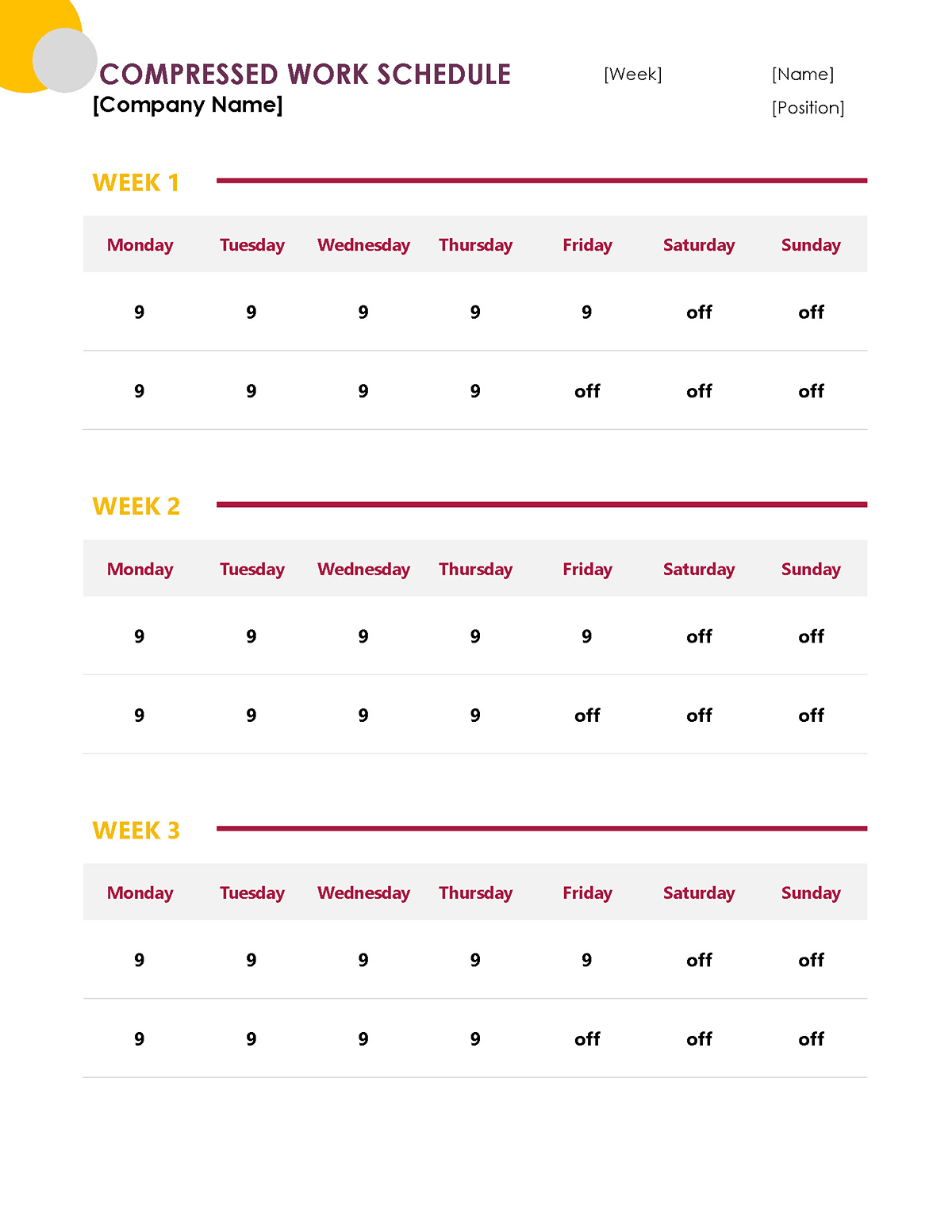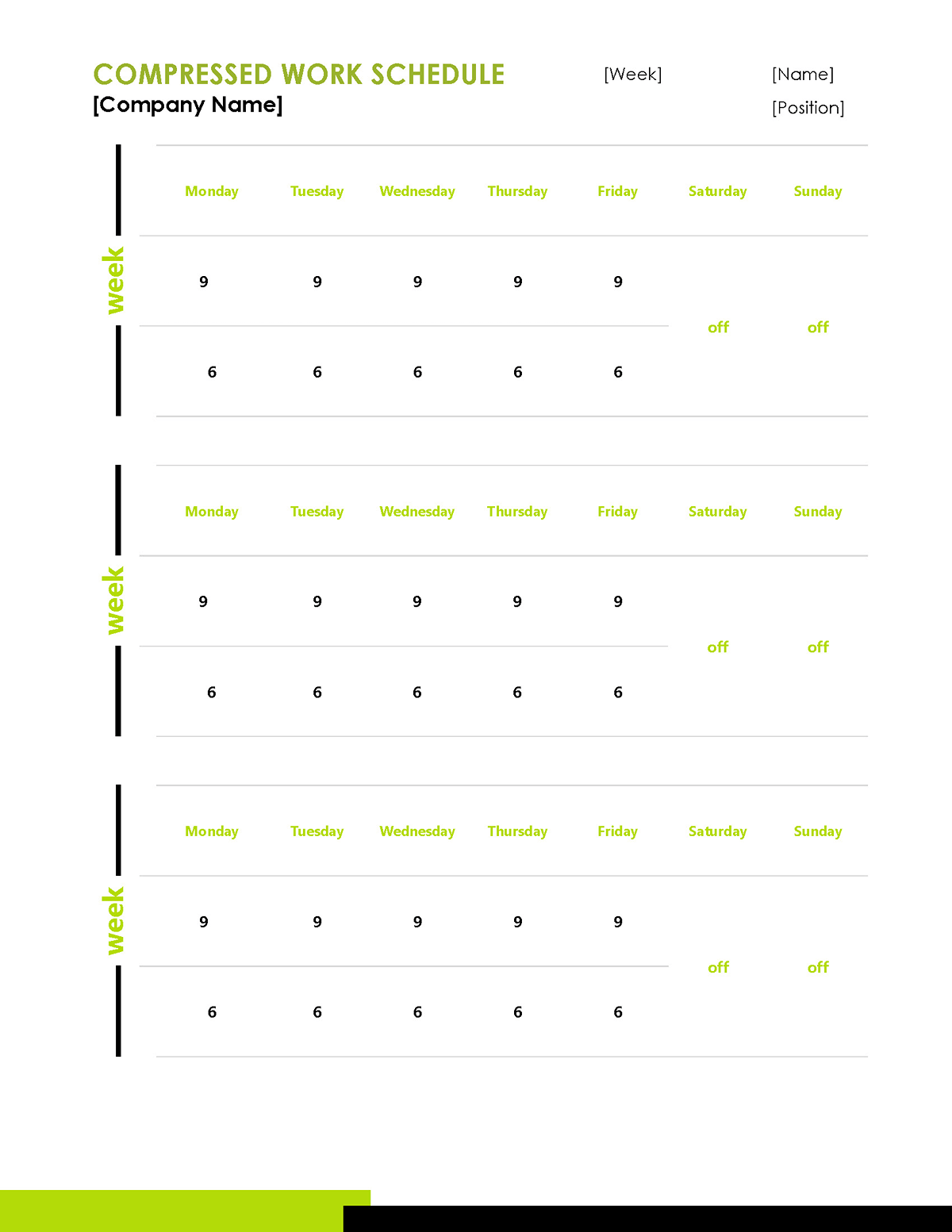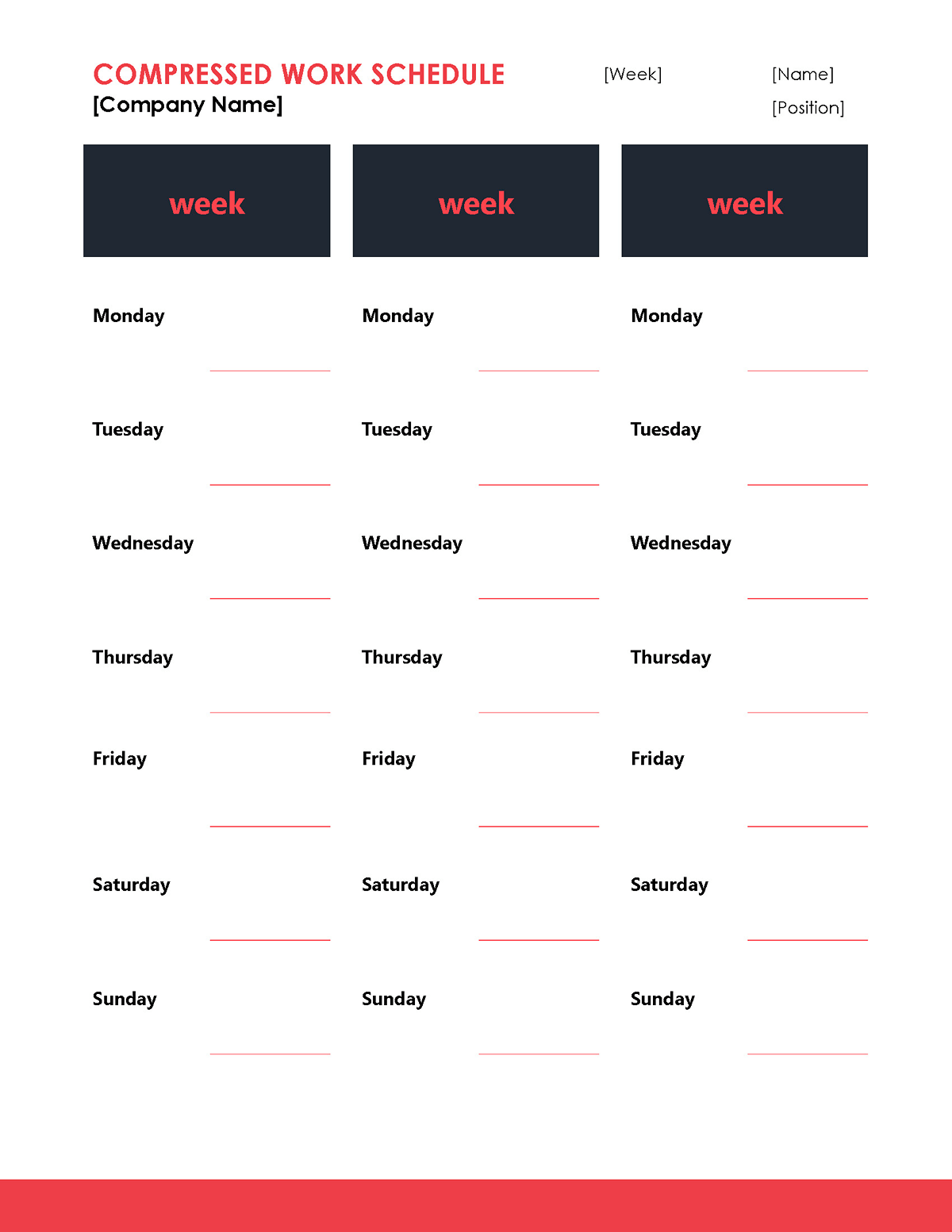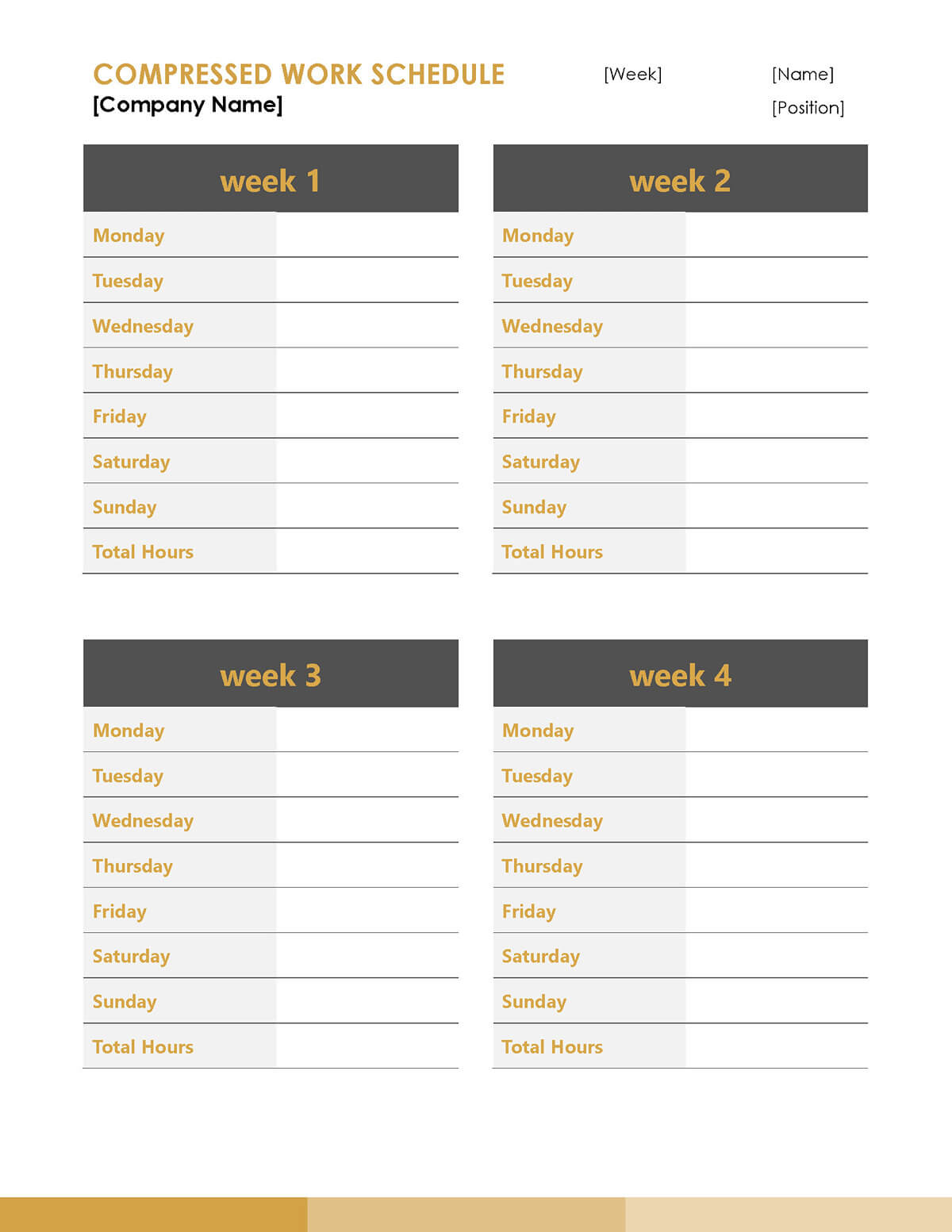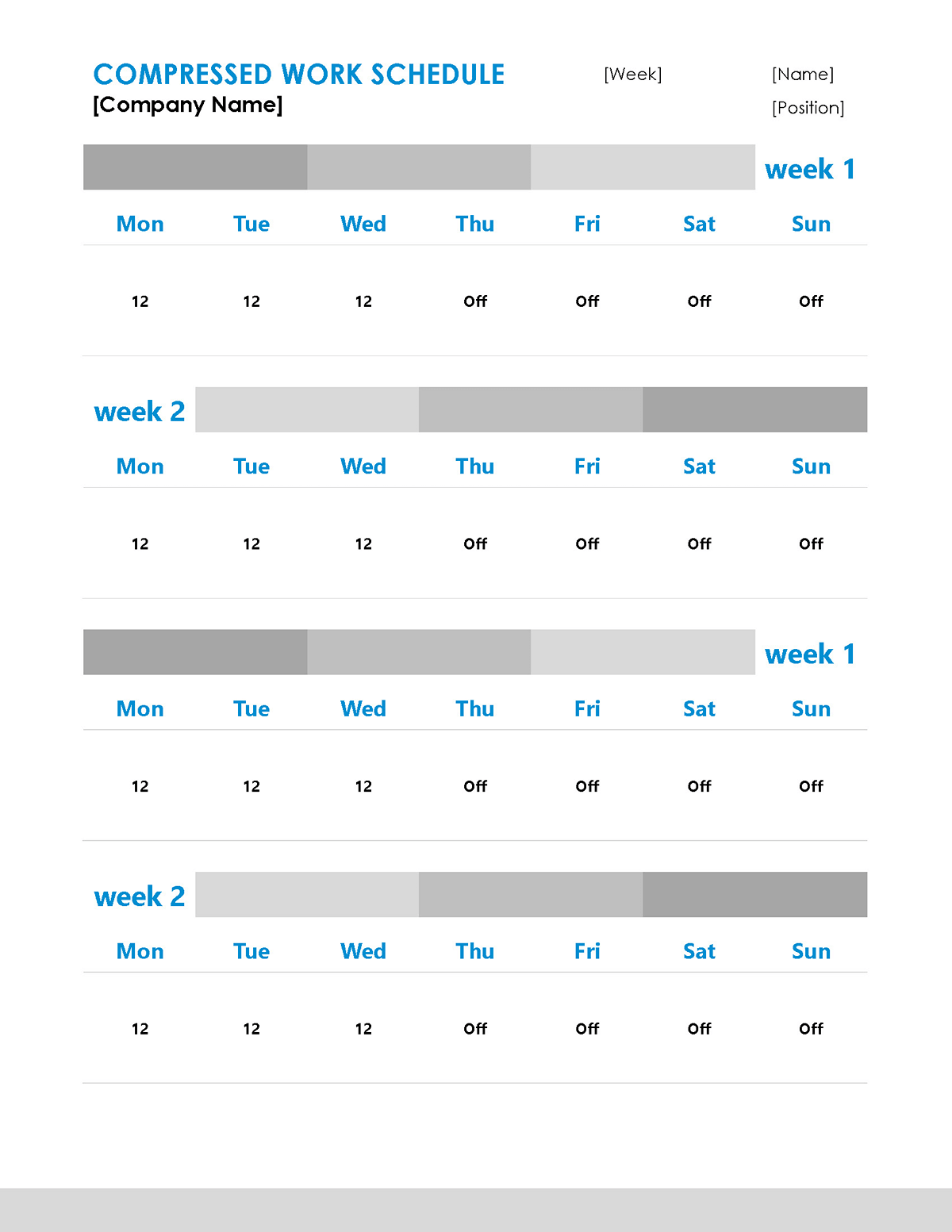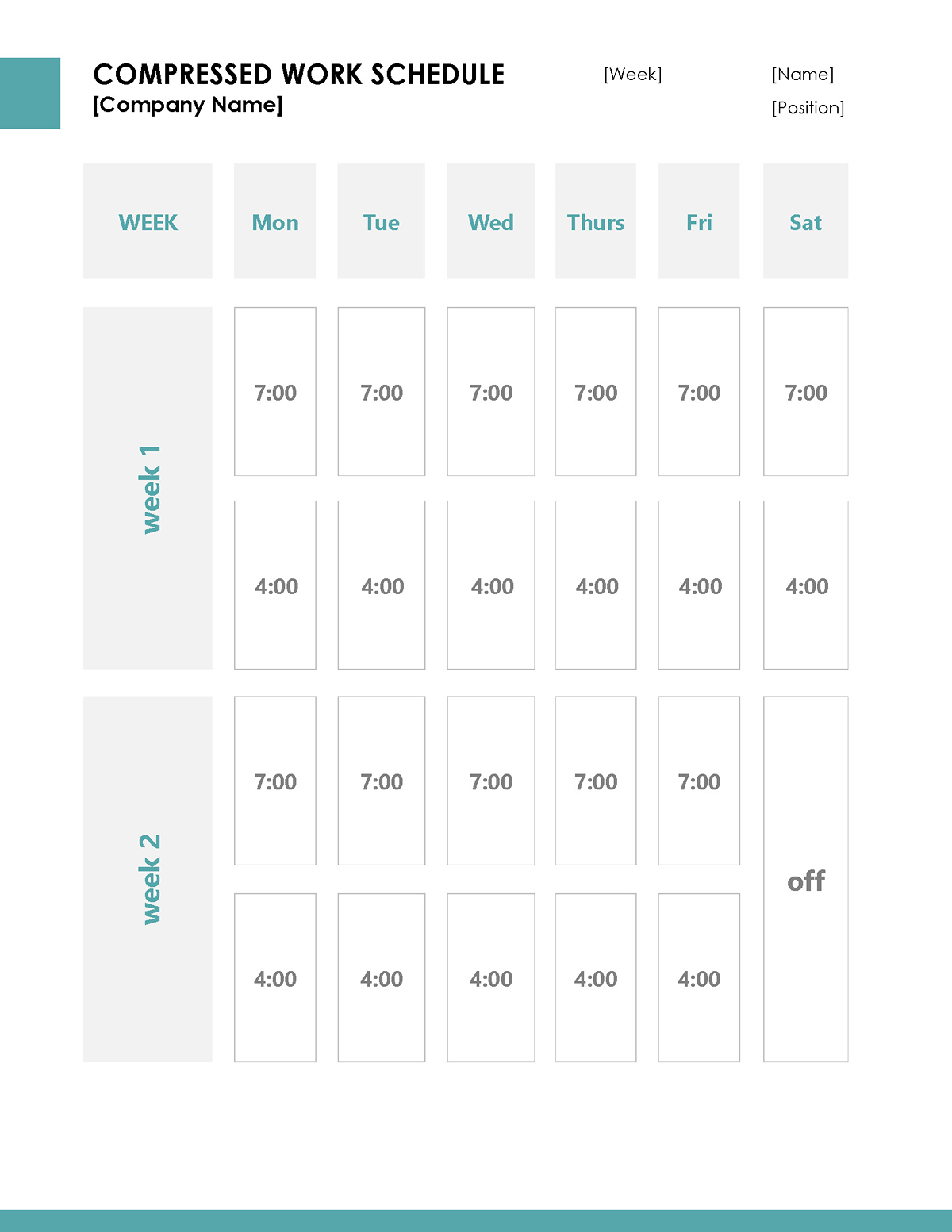Do you think you can work more hours each day to get an extra day off? Have you considered a suitable schedule to help you spend more time with your kids or pursue a hobby? Employees may opt for a compressed schedule at work because it offers flexibility and helps to achieve a better work-life balance without sacrificing income or benefits.
Some employers offer an alternative to the usual Monday to Friday, 9-5 schedule. The purpose of a compressed workweek is to allow employees to have an extra day off. In addition, companies may offer flexible working arrangements to attract a high-level workforce without spending too much on salaries and other benefits. As a result, a small business can compete with big corporations for elite talents.
This article will cover the definition, challenges, advantages, disadvantages, and templates of a compressed work schedule.
Compressed Work Schedule Templates
A flexible working arrangement has its pros and cons. Therefore, it is necessary to consider your industry and position before opting for the arrangement. However, suppose you have decided that flexibility in working hours is the best option. You can download FREE compressed work schedule templates here. These templates are customizable. In addition, they help organize flexible work hours.
What is a Compressed Work Schedule?
A compressed work is a form of a schedule that compresses the typical 35-40 hours workweek from five days to fewer days, usually four days.
Therefore, instead of waiting until Saturday to begin the weekend, the employee can have a free Friday because they are done with their work by Thursday.
For example, an employee has to work 40 hours for five days. The traditional schedule dictates that the employee must work 8 hours each day. However, the compressed schedule allows the employee to work 10 hours daily. Therefore, all the work is done within fewer days.
The compressed schedule at work is a flexible alternative often practiced in some industries. They include:
- Retail
- Manufacturing
- Forestry and mining
- Education
- Utilities
- Health care services
A compressed work arrangement is one of the various flexible work schedules. Others include:
- Part-time job: It involves working less than the usual 35-40 hours per week at a job
- Remote jobs: Remote jobs involve working from a location that is not the designated official location
- Flextime: A work arrangement that permits employees to choose their resumption and closing time of the workday
- Job sharing: An employment arrangement where two or more individuals share a job
Important: Another common alternative is a nine-day/two-week schedule. This arrangement permits the compression of 10 days of work into nine (or nine and a half) days. However, it may be challenging to establish the nine-day/two-week for non-exempt staff. In addition, FLSA mandates that non-exempt staff who work more than 40 hours in a workweek qualify for overtime pay. Likewise, this law applies to non-exempt staff who work for more than 80 hours of a pay period. The overtime pay is determined by multiplying the regular rate by 1½ times. In addition, the Department of Labor and Duke payroll practices mandates that workers get paid for their overtime after working. This poses a challenge as it would be difficult to calculate the payments due to the varying work schedules necessary to accommodate the nine-day/two weeks.
Things to Watch Out for Before Making a Work Schedule
Suppose you are determined to make flexible work schedules. Before suggesting the arrangement to your boss, consider some critical things.
Here are some things to consider:
- What are your working days, and how many hours will you work each day?
- Can the office contact you on your off days in an emergency? (what incidents can you classify as an emergency?)
- How does your new schedule fit into sharing responsibilities with your team members?
- What is the impact of this arrangement on the productivity of your team?
Tip: Before arranging flexible working hours, identify specific points highlighting its advantage to increased productivity. The proposal for a flexible work schedule has a higher chance of approval when the advantages are primarily about the department.
Challenges Faced by Employees in a Compressed Work Schedule
A compressed schedule may have numerous advantages at work. However, this work arrangement comes with its challenges. Here are some challenges faced by employees who adopt flexible work hours:
- A compressed work week requires longer working hours. As a result, the employee may be mentally and physically drained.
- It may trigger some feelings of dissatisfaction among employees who are not permitted to follow this schedule but work long hours.
- Flexible working arrangements become problematic when employers need to calculate the wages of non-exempt employees who work more than 40 hours.
- Employees who follow a compressed schedule at work may experience some challenges regarding transportation and dependent care options on the days they have to work longer.
Implementing a Compressed Work Schedule
A proper understanding of how to implement a compressed schedule at work is essential before you seek approval from your supervisor. You need to consider some points that will aid the successful schedule implementation. For example, non-exempt staff must get approval for all the extra hours (more than the usual 40 hours) in a week. Therefore, non-exempt staff who chooses flexible work hours should take their day off in the week it is due. This is important to avoid issues with overtime payment.
Here are some steps to implement a flexible work schedule:
Coordinate with all departments
The work process in an organization may be distorted due to poor implementation of flexible working hours. Therefore, coordinating with other departments is essential to ensure the organization’s smooth running. Supervisors may only approve day offs when there are enough staff members for a smooth workflow. The flexible timetables will become disagreeable when employees cannot meet their deadlines, and the organization cannot offer proper coverage.
Create a policy
One crucial step before implementing flexible work arrangements is to create a policy. This policy should indicate who is qualified for the arrangement, when it can be used, who makes the schedule, and how to apply.
Stay flexible
Flexibility should be on your mind when implementing a compressed schedule. However, the number of hours may vary according to the department. Therefore, you may need to consider the departmental functions. For example, working in the sales department may not require you to always be in the office from Monday to Friday.
Tips for Successfully Implementing a Compressed Work Schedule
When it comes to implementing, a flexible work schedule may seem like a stress-free idea. However, it requires you to work smarter and more challenging to achieve your goals. In addition, it requires a good understanding of time management and prioritization.
Here are some tips for successfully implementing a compressed schedule at work:
Set goals for yourself
The first step is to set goals for yourself. It helps if you set realistic and achievable goals on a weekly or monthly basis using OKRs (objectives and key results are a simple tool to track goals achievement) or any suitable method. Avoid consenting to unplanned activities, as they may become barriers to achieving your goals.
Consider the law
Before implementing a compressed schedule, consider the city and state laws regarding the overtime payment policy. This arrangement may be an ideal strategy for you. However, if it goes against the laws, the organization may incur some problems. Therefore, ask questions from the state’s labor office to confirm you are not breaking any employment laws.
Practice good calendar hygiene
One of the tips for successfully implementing a compressed schedule is practicing good calendar hygiene. This entails scheduling activities in a way that will maximize productivity. For example, the arrangement may involve rescheduling meetings within a specific time. As a result, you have more time to focus on work without meeting interruptions.
Structure your daily schedule
A compressed schedule requires you to plan your daily activities. Structuring your daily activities means more time to work and complete your scheduled tasks. Therefore, you need to allocate lesser time for breaks and lunch. Remember, you are still working the total hours but one day less. So, it would be best not to waste time on unnecessary activities.
Poke your head up
Working with a compressed schedule means longer work hours for lesser days. This can easily lead to fatigue and low productivity. However, you can take a short break to relax your body and mind. For example, suppose you feel overworked; taking a 5 or 10-minute walk can help you recharge.
Reflect, review, and adapt
Schedule a time, maybe once a month or three months, to review the impact of the compressed schedule with your supervisor. Be open-minded about any corrections and politely raise any challenges hindering your productivity.
In addition, it is essential to reflect on your progress and productivity since you began the compressed schedule. Suppose the compressed work arrangement is not beneficial to you and the department. Talk to your supervisor about going back to your regular work hours. Therefore, reflecting, reviewing, and adapting are essential to a compressed work arrangement.
Advantages and Disadvantages
At work, a compressed schedule has its benefits and drawbacks. In this segment, we shall examine the advantages and disadvantages to help you make an informed decision.
Advantages
Here are some advantages of compressed schedules at work:
- On a flexible work timetable, employees spend less time and money commuting during the week as they do not have to go to the office during rush hours.
- More time to pursue personal endeavors, such as spending quality time with the family.
- Increased productivity because employees are less distracted when working extra hours as many colleagues may have left.
- Extended customer service periods to provide support for those who need them at later hours.
- Income is protected while employees work for lesser days and enjoy personal time
- Employees are less likely to take an excuse to attend to a personal need, which may reduce productivity.
- Employees enjoy a day off while getting their full salaries.
- This schedule helps employees to enjoy a balanced work-life relationship.
Disadvantages
Here are the disadvantages of a compressed schedule at work:
- Working for more extended hours may be more demanding than you can imagine. Therefore, this can lead to fatigue, which reduces productivity.
- Care of children may pose a challenge when you have to work extra hours.
- The flexible work arrangement may cause some inconveniences due to understaffing on some days.
- This arrangement may make workers eligible for a different compensation schedule, such as overtime pay, following state laws.
- It may be inconvenient to schedule meetings with clients, partners, or shareholders.
- Persistently working for longer hours may eventually lead to reduced productivity.
- Less supervision during extra working hours.
- Working for extra hours may not be suitable for some jobs due to the risk of errors or accidents.
Frequently Asked Questions
How are leave times and holiday pay managed?
An employee with a flexible working arrangement is not exempted from paid leave. However, they will remove the hours they were supposed to work on their day off. For example, 8 hours of leave will be deducted if an employee takes the day off on a workday with 8 hours of work time. Employees are entitled to earn 1/5 of their original pay for a university holiday.
Is a compressed workweek suitable for you?
Before you can correctly determine if the compressed workweek is for you, consider some factors. The job description and your lifestyle are key factors that must be carefully considered before making this decision.
Another question you may need to ask is, what will I do on my extra day off? It can be used to spend time with your family, pursue a hobby, or whatever you desire. Suppose you do not have a concrete reason. You gradually become unmotivated to work longer hours.
In addition, you have to give honest answers to some questions regarding adjusting to this arrangement. For example, can you get home in time for dinner? How easy will it be to find transportation to get home? Who will stay with the kids? These questions are essential to determine if the compressed workweek is right for you.
Why do employees like compressed work schedules?
Despite the toll on mental and physical health, some employees like the flexible work schedule. It offers them a chance for a healthier work-life balance. In addition, employees who have to endure a long trip to and from work may prefer this schedule. It saves them the stress of being on the road for an additional day.
Do some employees dislike compressed work schedules?
Yes, some employees dislike the compressed schedule. Due to personal obligations, some employees may be unable to work extra hours each day. In addition, most employees prefer to work in shorter intervals for their sanity.
What is a 4/10 compressed work schedule?
A 4/10 compressed work schedule is a standard work arrangement. Employees have to work four days a week for 10 hours each. Therefore, they have three days off (Friday, Saturday, and Sunday). This arrangement is not mandatory, and no employer will force it on you. Instead, the employee must consider their job role and personal issues to request a 4/10 schedule.
What is a 9/80 compressed work schedule?
A 9/80 schedule is an alternative to the 4/10 schedule. This arrangement involves working nine instead of ten days in a two-week work cycle. For the first week, employees work 9 hours for four days and eight hours on the fifth day. Then, they work 9 hours for four days in the second week. Therefore, they can take one extra day off within two weeks. The resulting work hours are 80. Suppose you find the 4/10 schedule problematic. Then, you can try the 9/80 compressed schedule.
